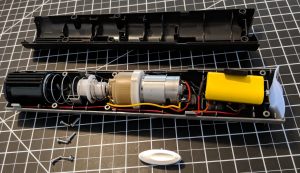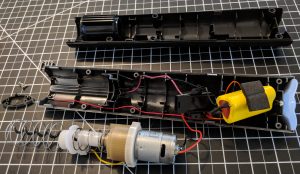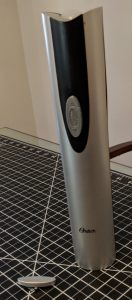After extensive research we’ve come up with what we consider the most cost effective audio kit one can buy, to provide a quality audio experience for yourself and your viewers when utilizing video conferencing solutions such as Zoom, Microsoft Teams, Google Meet, etc. This kit includes a low profile wired earphone, head mounted mic and audio interface, which will provide audio isolation (avoiding feedback) and quality input to you can be heard and understood most effectively in meetings.
To this end, we recommend the following components:
- Pyle Over-ear Microphone
- HYS Earphone (set of two)
- Sabrent USB Audio Adapter
- USB Extension Cables (set of two)
This microphone costs less than $11 and yields a very acceptable audio quality that can be exceeded by devices costing upwards of $80 but is a great value.

This HYS earphone comes in a set of two, so if you’re building your kits in even numbers, you’ll be able to do so most cost effectively. It comes with both open-bck and ports style earbud tips, for maximum comfort and flexibility.
This is the audio interface taking 1/8th inch analog inputs and provides USB output to your computer.

The USB extension cable set gives you a pair of two meter long extension cables that should facilitate optimal range for your wired audio kit. This mechanism also gives you a convenient disconnect point typically adjacent to your waist, that will allow you to step away from your computer without having to remove your entire audio setup from your head and ear.

I was handed an Oster Cordless Rechargeable Electric Corkscrew with a broken front button. The button is secured by two arms with retainer pins, creating an axis on which the button swivels, enabling forward and reverse operation of the device. While the device itself is a $30 item, so easily replaceable, and the hour or two it took to design, refine and install a 3d printed replacement is probably not justified, once designed I felt it was worthwhile to post the replacement button, because the installation itself took less than 10 minutes so might be justifiable, for anyone else experiencing the same problem – that being likely the most common mode of failure for these devices.
If you find yourself with one of these electric corkscrews with broken button pins, feel free to download and print this replacement button (material cost $0.16 in PLA). While it may appear that you can install the button from the frond that properly compressing the arms to get the pins aligned for proper insertion to be a daunting process, so I elected to disassemble the unit and install the button from the back (inside) of the case. First, move the two sets of rubber nubs from the back side of the old button, to the new button, inserting the nubs into the target holes on the new 3D printed button, that match those on the original button. These rubber nubs are critical to proper operation of the device switch once the button has been installed.
 Now disassemble the corkscrew, separating the clamshell case, taking care to contain the large spring that preloads the corkscrew actuator at the base of the unit. There are several individual parts that comprise that element of the unit, so to save time, try to keep them arranged on the corkscrew shaft in the proper order, so as to avoid reassembly hastles. You will need to remove the motor from the switch side
Now disassemble the corkscrew, separating the clamshell case, taking care to contain the large spring that preloads the corkscrew actuator at the base of the unit. There are several individual parts that comprise that element of the unit, so to save time, try to keep them arranged on the corkscrew shaft in the proper order, so as to avoid reassembly hastles. You will need to remove the motor from the switch side
 of the clamshell, and unscrew the switch PCB from the inside of the housing, in order to install the new switch button, but that installation will be quite straight forward, and the button pins willswivel freely in holes in the metal/plastic arms associated with the switch PCB. Screw down the switch PCB completely, which will provide compression against the underside of the button, securing it in place. Reinstall the motor in the switch-side of the clamshell c
of the clamshell, and unscrew the switch PCB from the inside of the housing, in order to install the new switch button, but that installation will be quite straight forward, and the button pins willswivel freely in holes in the metal/plastic arms associated with the switch PCB. Screw down the switch PCB completely, which will provide compression against the underside of the button, securing it in place. Reinstall the motor in the switch-side of the clamshell c ase, compressing the large actuator spring, which will be held in place by the baffles built into the the clamshell. Align and secure the opposite side of the clamshell with the case screws, and you should once again have a fully operational electric corkscrew.
ase, compressing the large actuator spring, which will be held in place by the baffles built into the the clamshell. Align and secure the opposite side of the clamshell with the case screws, and you should once again have a fully operational electric corkscrew.
In 2018, I’m going to start consolidating my online activities and publically available resources here. Over the next few months you’ll find more materials migrating here from the far reaches of the net, that I’ve fabricobbled together over the past 25 years of thinking, building and hitchhiking on the series of tubes that comprises what the kids and Al Gore used to call the Information Superhighway.
If I run out of more important things to do, I might even switch this site from the default theme to a more interesting/useful design… Don’t hold your breath though.
While it’s commonly said that influencer marketing hit the mainstream in 2016, there are equal numbers of articles discussing the backlash against this style of marketing from the same period, although if you look at the digital ad spend for 2016, influencer marketing doesn’t even tick the meter http://www.oftwominds.com/photos2017/digital-adverts1.gif though people were simultaneously touting it’s mainstream adoption and downfall. From that point we’ve seen steady growth. In the equities market we call that ‘Climbing the Wall of Worry’ – the concept that the frequent active discussion creates a mild volatility but more importantly, keeps the subject of that discussion top of mind for investors, so we see an inevitable growth; the alternative being a lack of worry, less discussion, and the subject falls off the radar for investors, or in this case advertisers.
We’ve seen the same phenomenon in other forms of online advertising. Going back to the early 2000’s we saw discussion of the demise of banner advertising, with the rise of contextual search advertising. What was in fact happening was publishers were seeing massive repricing of banner advertising inventory and throwing a fit. Eventually, the market stabilized with meaningfully contextual hybrid in-place advertising, still at a significantly lower CPM. Again, once advertisers had meaningful performance data on which to calculate their true ROI, there was a backlash causing Google to almost completely abandon their CPM advertising pricing in favor of CPC.
To further compensate, we saw the emergence of advertorial content, where there was an almost immediate backlash – often from traditional editorial writers – yet this form of marketing has survived and stabilized as a mainstream approach – to such an extent in fact that the New York Times has doubled down on that approach pioneered as a core business model by Buzzfeed https://www.recode.net/2017/6/21/15842732/code-commerce-ben-kaufman-buzzfeed-david-perpich-wirecutter-new-york-times
More recently, now that we’ve got over a decade of search advertising ROI data, we’ve seeing major brands P&G and Restoration Hardware fleeing search advertising as having an ROI near zero http://www.zerohedge.com/news/2017-09-11/startling-anecdote-about-online-advertising-restoration-hardware for them. It’s worth pointing out here, that the problems experienced by these brands were of their own making as they were arguably using search advertising ‘incorrectly’ as a substitute for proper SEO – the fact that Google has effectively crushed all innovation in the SEO space is a discussion for another time.
With the benefit of hindsight, we can now see that banner advertising – despite all it’s early naysayers – survived until around 2010 as a viable business, when advertorial content became preeminent, with the accelerated adoption of mobile devices. The 2016 election was potentially the height of advertorial content (meaning the NY Times may have bought Wirecutter at the high) which brings us to influencer marketing. As this marketing style ‘hits the mainstream’ much as occurred with search advertising, and banner advertising before it, with a meaningful quantity of historical performance data, we see (and I predict, will see further) repricing of influencer compensation to more accurately reflect the ROI they bring and along with it, influencers crying foul, as the easy money disappears from the market space. Still, influencer marketing will continue to climb the wall of worry, at least until it warrants a significant enough spend to appear in digital ad spend analyses and until mobile video is supplanted with another preeminent medium – likely Augmented Reality, where we’ll likely see the re-emergence of content branding and contextual competitive vendor positioning, or hopefully a new and innovative advertising approach, to which consumer will be less sensitized.



